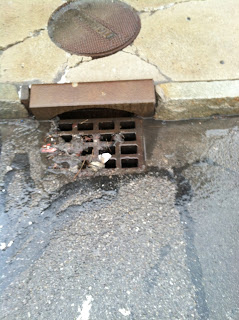Since I could not visit my spot in the quad this week, I decided to do some exploration around my neighborhood in Rochester, NY. As I was walking my dog, I took notice to this blue plaque right above the storm drain located on my street. It reads "Keep Clean. Drains to Lake. Be an H20 Hero" and it lists its website:
H2OHero.org. Being as inquisitive as I am, I came right home and checked it out. The website is apart of the Water Education Collaboration (WEC) awareness campaign designed to educate the residents of the Genesee Regional Watershed of Lake Ontario about the enormous impact they have on the water quality in the area. With Lake Ontario being a short bike ride away from my home, it never occured to me that I lived in a watershed region. I was also informed (from
H2OHero.org) that a watershed "is an area of land that drains into a body of water, such as a river, lake, reservoir, estuary, sea, or ocean."
When you first arrive to the website, there is an interactive interface that addresses 5 ways to keep the water clean (or as the site says "5 super things you can do to be an H2O Hero"). They include:
1. Clean up after your pets; 15-20% of bacteria in our waterways comes from pet waste.
2. Test your soil prior to fertilizing and be smart about the use of lawn chemicals in order to prevent harmful runoff into the lake
3. Dispose of chemical materials properly, don't just throw them in the trash or down the storm drain.
4. If you change your oil in your driveway, be mindful of oil reaching the storm drain
5. Avoid washing your cars in your driveway to prevent detergents from getting into the lake
Now how does this relate to the storm drain situation near Canisius College...
I think the WEC campaign near my home is working as all the storm drains I have recently come in contact with are free of debris and I have not personally observed any of my neighbors break the 5 guidelines to keeping Lake Ontario clean.
Let us compare the data between
Lake Ontario/Genesee River Watershed VS Niagara River/Lake Erie Watershed:
45% of Rivers were unassessed
8% of Rivers were found to be poor
26% of Rivers were found to be satisfactory
21% of Rivers were found to be good
21% of Lakes were unassessed
60% of Lakes were found to be poor
19% of Lakes were found to be satifactoy
0% of Lakes were found to be good
42% of Rivers were unassessed
17% of Rivers were found to be poor
8% of Rivers were found to be satisfactory
33% of Rivers were found to be good
56% of Lakes were unassessed
6% of Lakes were found to be poor
28% of Lakes were found to be satifactoy
11% of Lakes were found to be good
*100% of Great Lakes Shores were found to be poor
Once again, to my amazement- even with the WEC campaign near my home, the lake condition of Lake Ontario seems to be worse compared to Lake Erie. However, this statistic is up for interpretation. On one hand, not all of the lakes were assessed (more was assessed in Lake Ontario, 79%, than Lake Erie, 44%). Also, the Department of Environmental Conservation states that all of the Great Lake Shores were found to be in poor water conditions. If this is the case, then why is there no public initiative to protect the Niagara River/Lake Erie Watershed like there is to protect Lake Ontario/Genesee River Watershed? I wonder if students were more aware of the watershed, if it would have an impact on reducing the amount of litter we generate, thus affecting the water quality of Lake Erie.
5 things students, faculty, and staff of Canisius College could do to improve the water quality of Lake Erie would be:
1. Throw all trash away in proper waste containers
2. Avoid distributing rock salt near storm drains
3. If you see rain drains are clogged with debris, remove whatever is causing the blockage
4. Be mindful of any chemicals or liquids that could runoff into the drain such as oil, gasoline, alcohol, soda (anything besides water)
5. As stated before, 15-20% of bacteria in our waterways comes from pet waste- avoid urinating in the storm drains. Not only is it illegal, it is disgusting












































